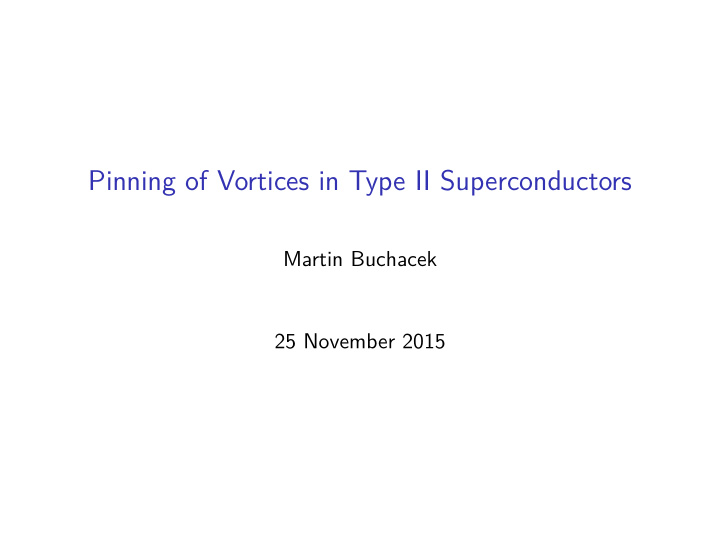



Pinning of Vortices in Type II Superconductors Martin Buchacek 25 November 2015
Type II superconductors ◮ 1935: vortex phase observed experimentally in 1935 by Lev Shubnikov ◮ 1957 theoretical model by Alexei Aborikosov (Nobel prize in 2003 together with V.L. Ginzburg) ◮ Most hight T c superconductors are type II
Vortex phase ◮ The most stable configuration is the triangular lattice � B B ( r ) � j | ψ ( r ) | ξ λ ≫ ξ r a △ � 1 / 2 � φ 0 ◮ a △ ≃ 1 . 075 B ◮ ξ is comparable to the size of single unit cell ( ξ ≃ 0 . 4nm in YBa 2 Cu 3 O 7 − x )
Onset of resistance ◮ Ideal type II superconductor where vortices are free to move develops resistance. B � B R ∼ R n B H c 2 � j ext , � E � f, � v H c 1 H c 2 H ◮ dissipation ∼ j · E ◮ If vortices are pinned, they do not move until we reach a critical current j c .
Pinning ◮ Real materials are not perfect superconductors ⇒ vortices of magnetic field are attracted to the local pinning centres line defects (screw dis- clocations) YBa 2 Cu 3 O 7 − x point vacancies twin planes separating regions of different unit 3D pinning centres cell orientation
Flux creep V eff = V − fu ◮ jump rate ∝ e − ∆ F 0 / T ◮ small currents: vortices are ‘locked’ in the valleys and jumps are rare ◮ large enough currents give rise to the critical force: the potential landscape becomes tilted and jumps are more frequent ⇒ sudden increase in resistance
Resistance in the presence of pinning c H = 8 T b H = 0 T a T = T m Figure 1: Resistive transition in YBa 2 Cu 3 O 7 − x crystal. Various magnetic fields applied are parallel to c -axis 2 2 W. Kwok et al., Phys. Rev. Lett. 69, 3370 (1992)
Phases of the vortex lattice ◮ competition between elasticity, disorder and thermal fluctuations ◮ glass phase: barriers diverge as j → 0 and inhibit vortex motion ⇒ recover ‘genuine’ superconductor with ρ → 0 ◮ disorder in the vortex glass phase is so strong that it destroys the vortex lattice structure
Pinning mechanism: weak vs. strong pinning ◮ Discussion above is related to the collective action of many ‘weak’ pins pinned unpinned x e ( x ) e ( x ) x x unpinned pinned weak pinning strong pinning ◮ Strong pins act individually on the vortices. At certain regions, there are bistable solutions with pinned and unpinned vortices.
Research tasks in the strong pinning theory ◮ Thermal excitations in strong pinning T theory ◮ Collective action of strong pins.
Thank you for your attention.
Resources G. Blatter, D. Geshenkbein: Vortex Matter. In Superconductivity, Springer 2008. ◮ General review of vortex matter phases in the introduction. ◮ The origin of strong pinning and bistable solutions is discussed in ch. 12.8. ◮ The general discussion of the glass phases can be found in the beginning of ch. 12.12 Introduction to Superconductivity (Tinkham). ◮ Flux creep is discussed in ch. 5.7 ◮ Flux motion and the effect of pinning in high- T c superconductors is discussed further in ch. 9.4 and following.
Recommend
More recommend